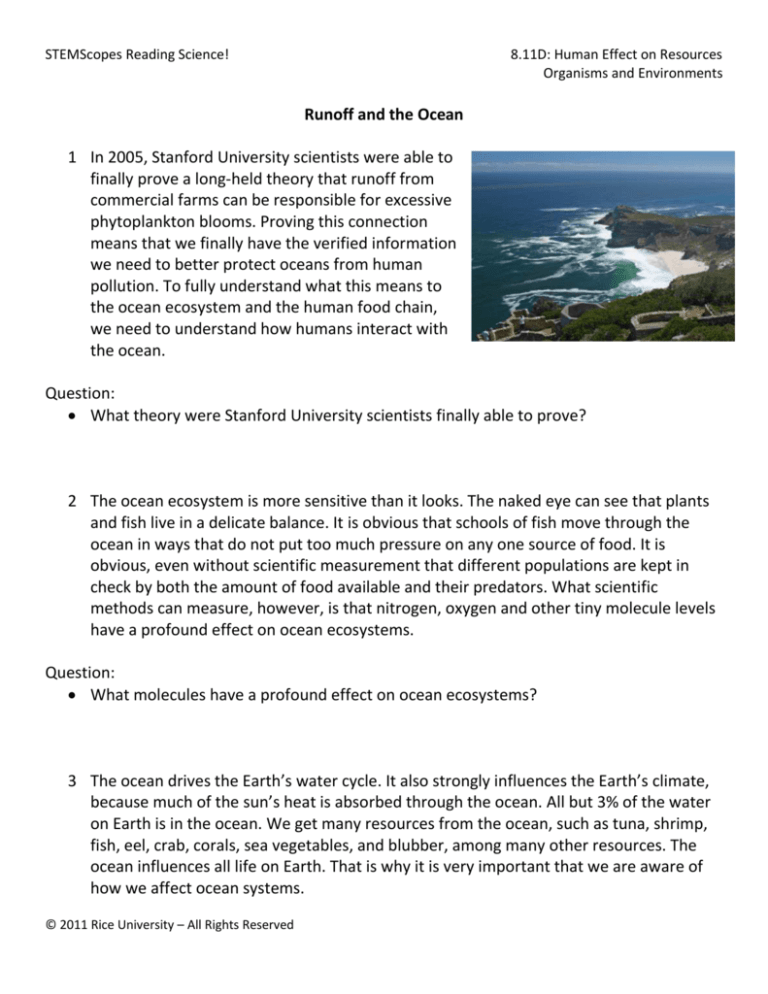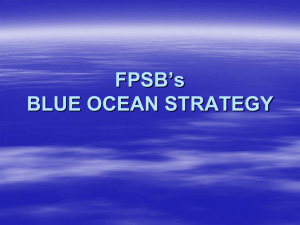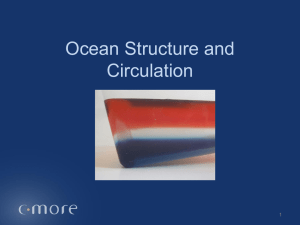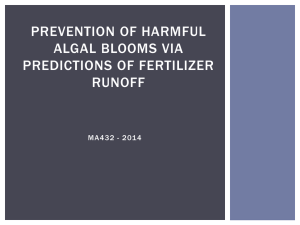
STEMScopes Reading Science!
8.11D: Human Effect on Resources
Organisms and Environments
Runoff and the Ocean
1 In 2005, Stanford University scientists were able to
finally prove a long‐held theory that runoff from
commercial farms can be responsible for excessive
phytoplankton blooms. Proving this connection
means that we finally have the verified information
we need to better protect oceans from human
pollution. To fully understand what this means to
the ocean ecosystem and the human food chain,
we need to understand how humans interact with
the ocean.
Question:
What theory were Stanford University scientists finally able to prove?
2 The ocean ecosystem is more sensitive than it looks. The naked eye can see that plants
and fish live in a delicate balance. It is obvious that schools of fish move through the
ocean in ways that do not put too much pressure on any one source of food. It is
obvious, even without scientific measurement that different populations are kept in
check by both the amount of food available and their predators. What scientific
methods can measure, however, is that nitrogen, oxygen and other tiny molecule levels
have a profound effect on ocean ecosystems.
Question:
What molecules have a profound effect on ocean ecosystems?
3 The ocean drives the Earth’s water cycle. It also strongly influences the Earth’s climate,
because much of the sun’s heat is absorbed through the ocean. All but 3% of the water
on Earth is in the ocean. We get many resources from the ocean, such as tuna, shrimp,
fish, eel, crab, corals, sea vegetables, and blubber, among many other resources. The
ocean influences all life on Earth. That is why it is very important that we are aware of
how we affect ocean systems.
© 2011 Rice University – All Rights Reserved
STEMScopes Reading Science!
8.11D: Human Effect on Resources
Organisms and Environments
Question:
What are two ways that the ocean influences life on Earth?
4 Water that travels over the ground and drains into a stream, lake, river or ocean is
called runoff. Precipitation generates most runoff, but pollution in the runoff frequently
comes from water that has been used for agricultural purposes. This is water that has
been used to irrigate the plants that farmers grow. Sometimes this water can collect
contaminants like lead, nitrogen and phosphorus from the ground as it rolls downhill.
Nitrogen is a chemical element that many farmers use to increase crop yields. It is the
“active” ingredient in manure and many other plant fertilizers. Unfortunately, it has the
same effect on ocean plants. This introduction of additional plant fertilizer into the
ocean changes the balance of ocean plant growth and can have serious consequences
for ocean wildlife.
Questions:
What is runoff?
Why is nitrogen in the runoff bad for the ocean?
5 Phytoplankton are microscopic algae that naturally exist in the ocean. Phytoplankton
form the base of the aquatic food chain and thousands of marine species rely on
phytoplankton for food. Individually they are too small to be detected. But when
millions of phytoplankton are together, they can be easily seen as a green color in the
water. The chlorophyll in their bodies causes the green color. When phytoplankton
quickly increase in numbers, theses large concentrations of them are called “algal
blooms”.
Question:
What is an algal bloom?
© 2011 Rice University – All Rights Reserved
STEMScopes Reading Science!
8.11D: Human Effect on Resources
Organisms and Environments
6 Algal blooms have been happening naturally since man has been recording observations
about the ocean. However, we have also begun to understand the relationship between
contaminated runoff and ocean algal blooms. Algal blooms can cause hypoxic
(low‐oxygen) areas in waters, because as the short‐lived algae die, oxygen is taken from
the water to help bacteria decompose their bodies. Hypoxic areas, or dead zones, are
places where most oxygen dependent life forms cannot live. Dead zones can cause fish
kills and other traumatic events where large amounts of a population die.
Question:
Why can’t fish live in hypoxic areas (dead zones)?
7 The scientists at Stanford University were the first to prove the connection between
nitrogen in runoff water and algal blooms. They studied aerial photos of the Gulf of
California. The land surrounding the Gulf of California is used heavily for agriculture.
Hundreds of thousands of acres are used as farm land. Farmers fertilize these farms four
times per year. They spray their crops with a nitrogen‐based fertilizer, which collects in
the runoff and drains into the ocean. What the researchers discovered was that there
was always an algal bloom within days of this fertilization cycle.
Question:
What was the connection that scientists discovered between nitrogen in runoff water
and algal blooms?
8
Since algal blooms can cause major problems for both aquatic life and commercial
fisheries, it is important to know exactly how humans can cause— and prevent —
abnormally concentrated algal blooms.
© 2011 Rice University – All Rights Reserved
STEMScopes Reading Science!
8.11D: Human Effect on Resources
Organisms and Environments
1. In paragraph 2 “Naked eye” probably means —
A. eyes without glasses
B. easily seen without aid
C. eyes without clothes
D. eyes without eyelashes
2. Algal blooms —
A. are caused by fish
B. only happen naturally
C. are always human-caused
D. are sometimes a natural occurrence and sometimes the result of human activities
3. In paragraph 2 “Kept in check” probably means —
A. controlled
B. intimidated
C. excessive
D. to eat
4. Rain water that runs over the surface of the ground —
A. always eventually gets soaked into the ground
B. is the best water to drink
C. can collect contaminants and run into the ocean
D. gets treated at the water plant
5. Which of the following is the best summary of the article?
A. Oceans are important part of the Earth. We get fish, shrimp and other natural resources from the
ocean.
B. When humans interact with the ocean bad things happen. We cause pollution when contaminants
runoff into the ocean.
C. Algal blooms can cause dead zones in the ocean. Humans are the main cause of algal blooms. We
should stop runoff, because it can cause ocean dead zones. We can stop harmful runoff by not
using nitrogen to fertilize plants.
D. Humans interact with the ocean in many ways. We gather food and other resources from the
ocean. Runoff is surface water that has traveled over ground and into a body of water. Sometimes
runoff, which reaches the ocean, is contaminated, which we now know can cause deadly algal
blooms.
© 2011 Rice University – All Rights Reserved








